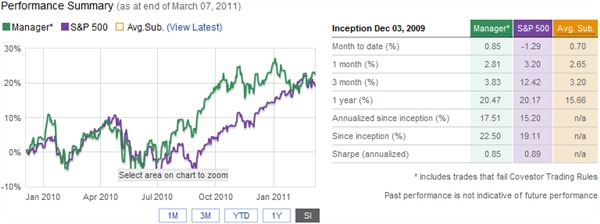 Author: Andy Djordjalian
Author: Andy Djordjalian
Covestor model: South America
Disclosure: None

I feel I should begin by apologizing about not delivering a report for February, more so considering that January was a poor month for the South America model and therefore an explanation would have been useful. This poor performance was a reflection of generalized losses in the region, which can be seen when we review the performance of some popular ETFs that I frequently use as benchmarks for this model. According to Morningstar, during these two months, iShares MSCI Brazil (EWZ) dropped 4.93%, iShares MSCI Chile Investable Market Index (ECH) lost 12.94%, Market Vectors Brazil Small-Cap (BRF) dropped 10.89% and Market Vectors Junior Gold Miners (GDXJ) lost 3.68% (specified dates: 1/3/2011 – 2/28/2011).
There are a number of possible explanations for the poor performance of the broad emerging markets since the start of 2011:
- Opportunity was seen in the U.S. and Europe, so capital moved from emerging markets into the developed world.
- Political unrest in northern Africa triggered a “flight to quality” that accentuated that movement. Those revolts were partly triggered by rising food prices, which have a greater impact in emerging economies because food comprises a larger proportion of total consumption.
- Besides its political consequences, high food prices leave less surplus for the new middle class to create the consumption thrust that is expected to drive developing economies.
- There are doubts about the emerging world’s ability to solve rising inflation.
- Institutional investors who are heavily invested in commodities saw these weaknesses —temporary or not— as an opportunity to hedge their investments by shorting emerging-markets stocks.
Regarding the second and third factors above, South America should be treated as a special case as, unlike other emerging markets, it produces large amounts of food, so those price hikes are expected to have a positive effect on salaries and the economy in general. Producing companies in South America employ these higher margins to invest and grow more rapidly, hiring more and better workers, and governments collect more from taxes. Moreover, the state of democracy in Egypt and Libya, or lack thereof, is nothing like that of the countries in this model.
Therefore, I do not see that those two reasons should have had a noticeably negative impact in the South American markets, but emerging markets were probably treated as a whole by investors without distinguishing among destinations. As few as two diversified emerging-markets funds, namely iShares MSCI Emerging Markets Index (EEM) and Vanguard MSCI Emerging Markets ETF (VWO), command around a hundred billion dollars in assets. When demand for these funds lowers, so does that of the other collective instruments that are invested broadly in the emerging world. This can cause a significant sale of South American stocks, regardless of their appeal in relation to the rest of the developing world.
Besides the particularities of South America among the emerging markets as a whole, there are reasons to doubt that the factors listed above are enough to justify, from an economic perspective, the downturn suffered by the emerging world. Lawrence Weinman makes some good points in his article on Seeking Alpha.
The fourth reason in the list above is more serious for Latin America, particularly Brazil, where the latest reports of inflation were a bit disappointing and are causing measures from the government such as interest-rate hikes and spending cuts. In other cases I may view this kind of overheating scenario as an opportunity to reduce my allocation and repurchase once the currency devalues, but this time I think the challenge is manageable and already discounted in stock prices, even in the event of a welcome depreciation of the Brazilian currency. The government has means for conducting policy that it has not used sufficiently yet, like fiscal cuts that can produce a larger effect on domestic consumption, or through its development bank, the BNDES. Moreover, if the developed world undoes its loose monetary policy and resumes pre-crisis import levels, Brazil will be significantly relieved from these challenges and its remarkable economic dimensions may become evident again.
I do not discard the potential for more bumps on the road, caused for example by more overheating signs in Brazil, debt troubles in the developed world, stumbles in the Indian or Chinese economies or the food crisis. Regarding the latter, I think we have not seen the worst of it. The issue will depend heavily on future weather which —as far as I understand— is pretty much unpredictable, but the expected situation is of concern given that a recovery in the demand for oil from the developed world would probably push farm prices up via these countries’ appetite for ethanol. The definitive solution for this problem may be the development of farmland in Sub-Saharan Africa — see, for example, “Africa farmland has potential of Brazil: Quifel”, but for the time being, the challenge looks too big for private enterprises alone and governments need to do more. In the meantime, South America benefits from high agricultural prices.
As I stated, I do not discard more bumps and volatility. Though I regret our recent losses, I am confident about the investments I hold in this portfolio and more generally I think that this may be an interesting entry point to access the long-term potential of the region. The portfolio has behaved well during downturns and now I hope it can capitalize from a recovery once more.
I wish you a productive and pleasant March and thank you for your interest in this model.
Sources:
“Asset Managers Have Turned Against Emerging Markets; Should You?” Lawrence Weinman. Seeking Alpha, 3/1/11. https://seekingalpha.com/article/255553-asset-managers-have-turned-against-emerging-markets-should-you
“Africa farmland has potential of Brazil: Quifel” International Business Times, 2/22/11. http://www.ibtimes.com/articles/115040/20110222/africa-farmland-has-potential-of-brazil-quifel.htm

